Improving EFL Vietnamese learners’ speaking ability through the 4/3/2 technique
Previous studies have showed the effects of different methods used in
teaching the speaking skill in language classrooms in Vietnam. Yet not many
language practitioners have focused on activities and techniques to improve EFL
learners’ speaking fluency. This study looks at the use of the 4/3/2 technique in
speaking classes. Data were collected through an experiment among first year
English majors who were following the usual English program at a university. It was
found that the treatment group outperformed the control group in terms of speaking
fluency and accuracy. The study highlighted the benefits of the 4/3/2 technique and
suggested that fluency and accuracy in language performance do not have to be in a
trade-off relationship.
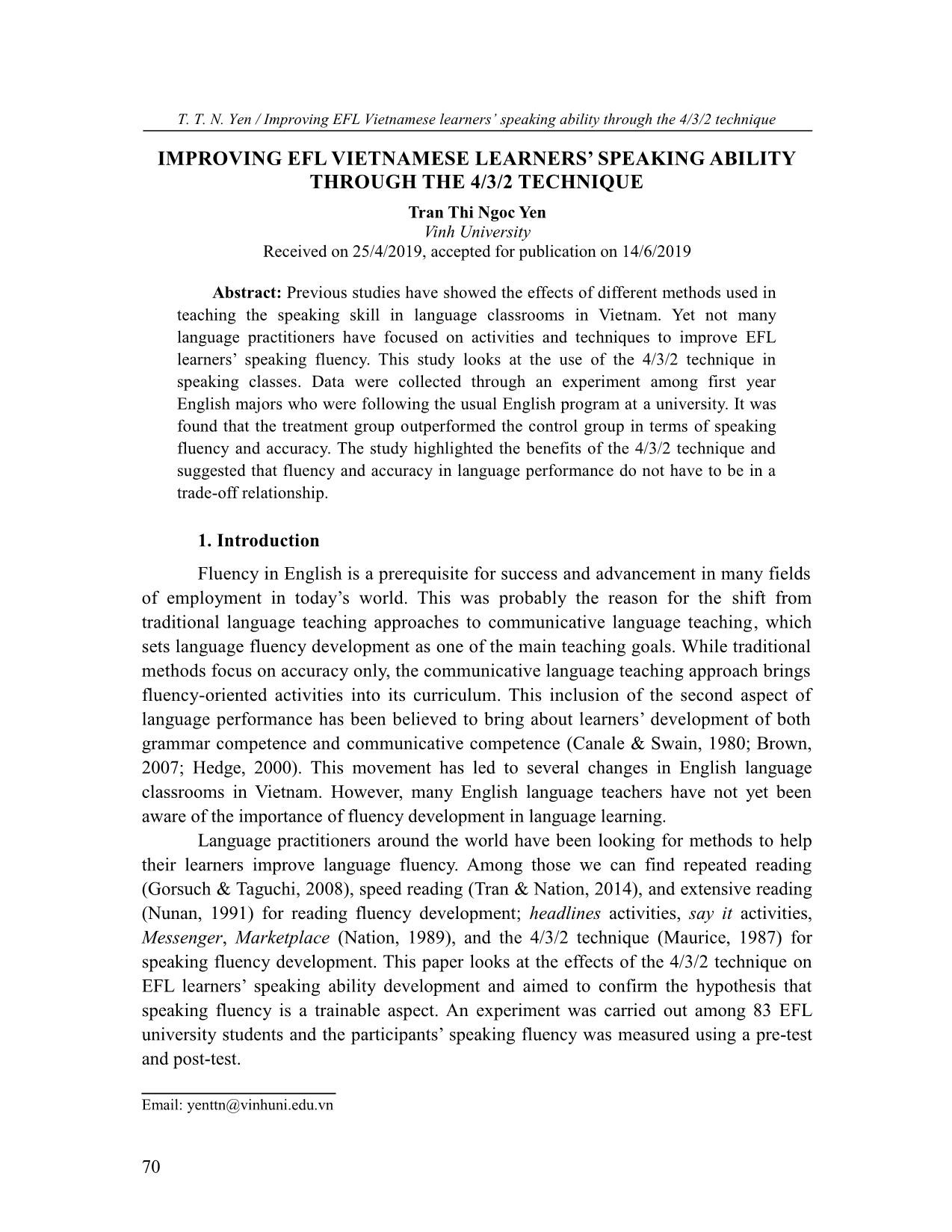
Trang 1
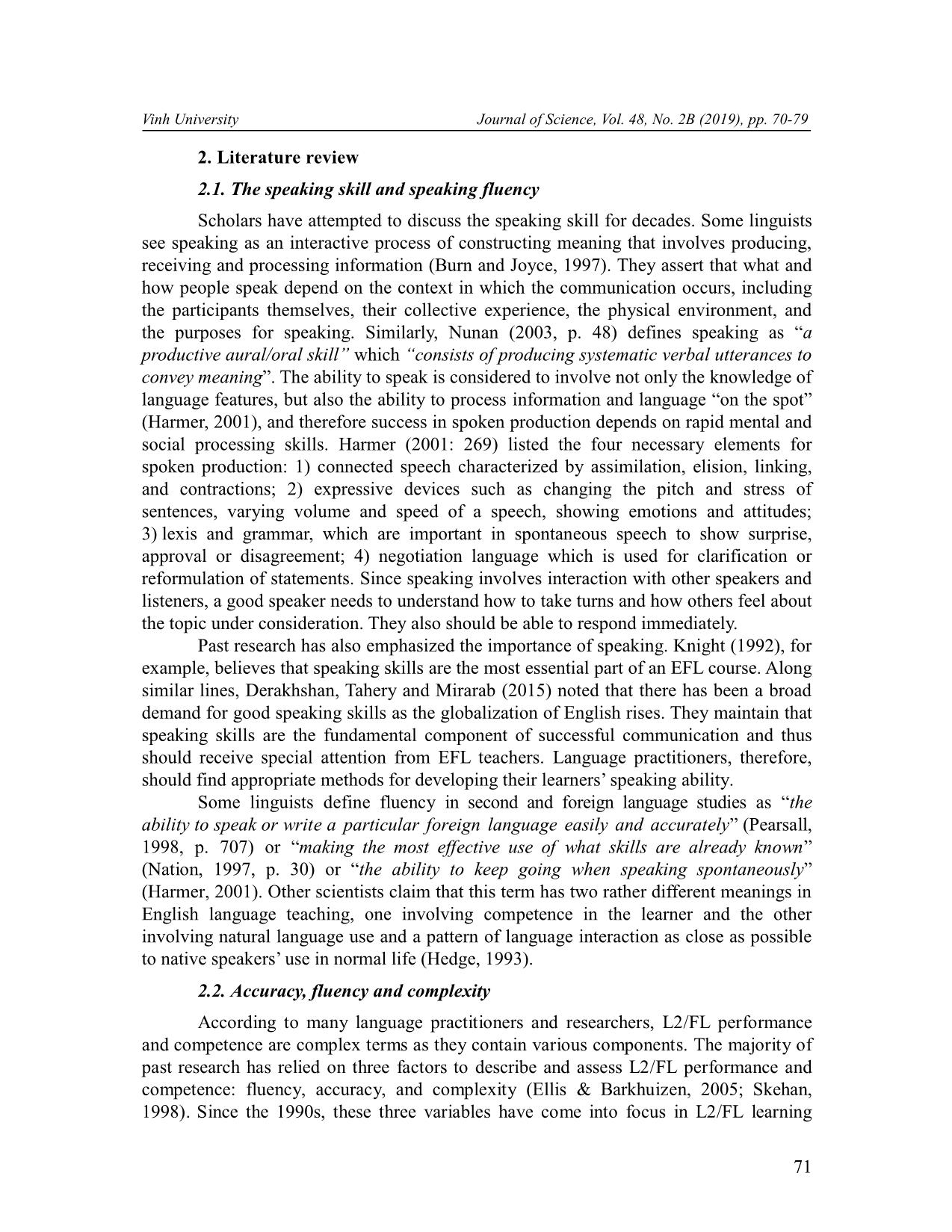
Trang 2
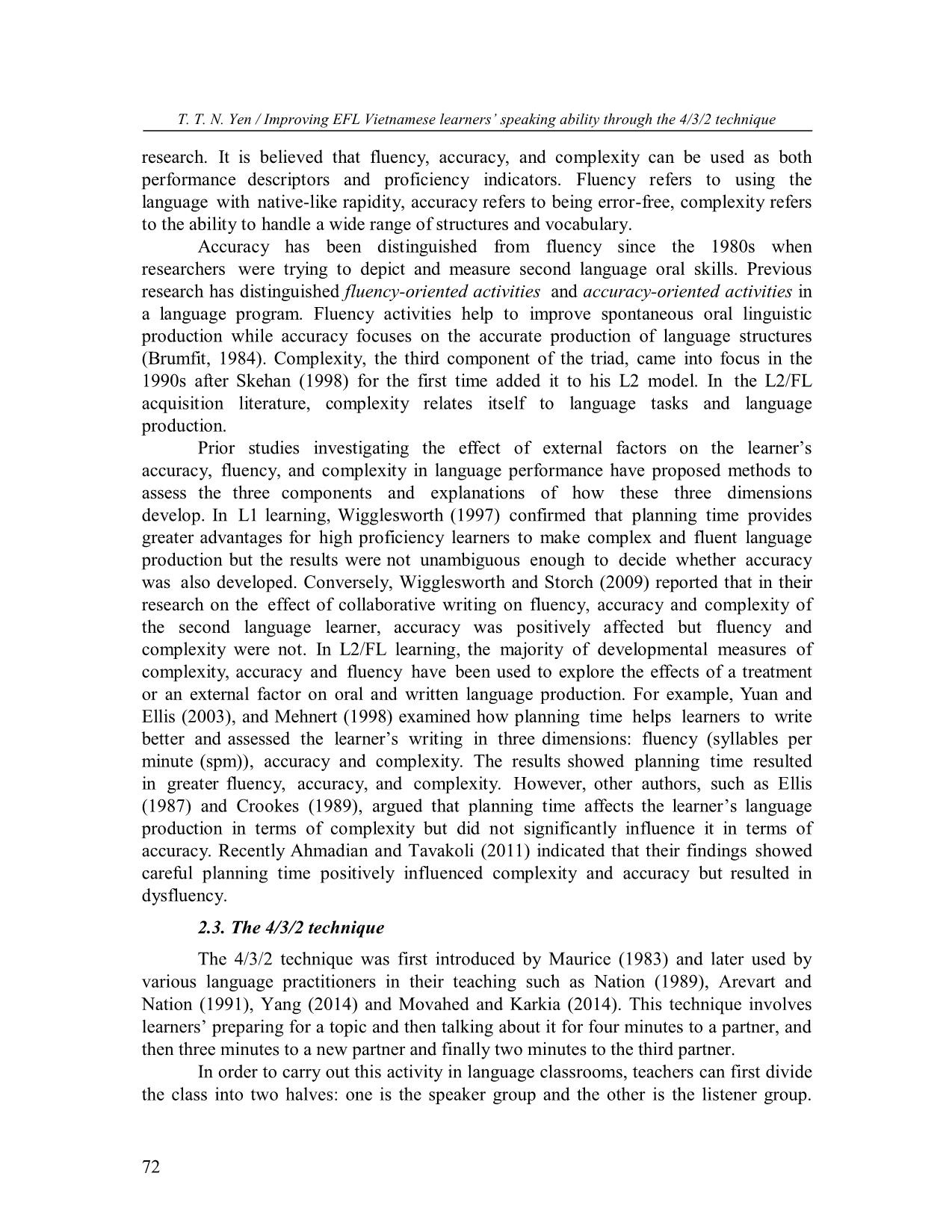
Trang 3
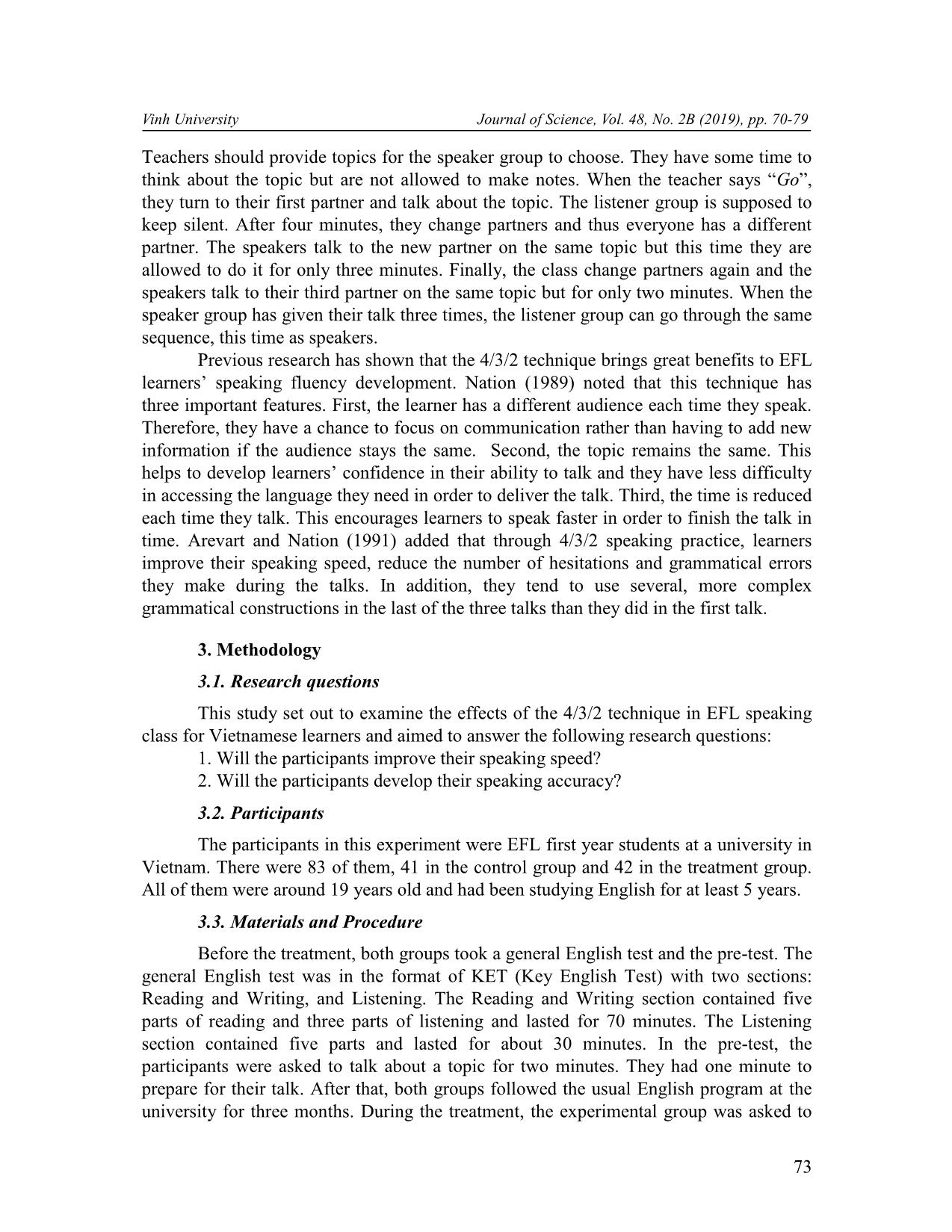
Trang 4
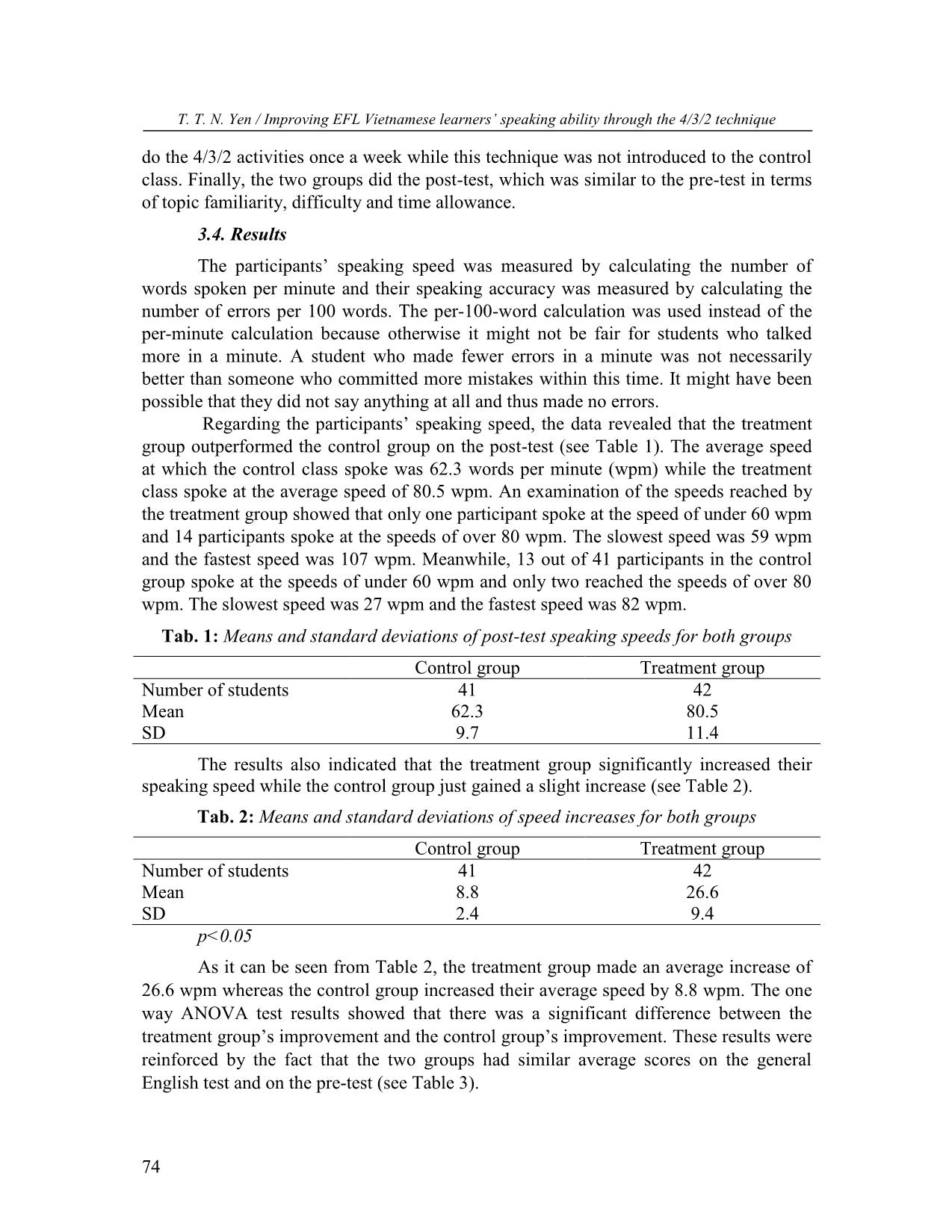
Trang 5
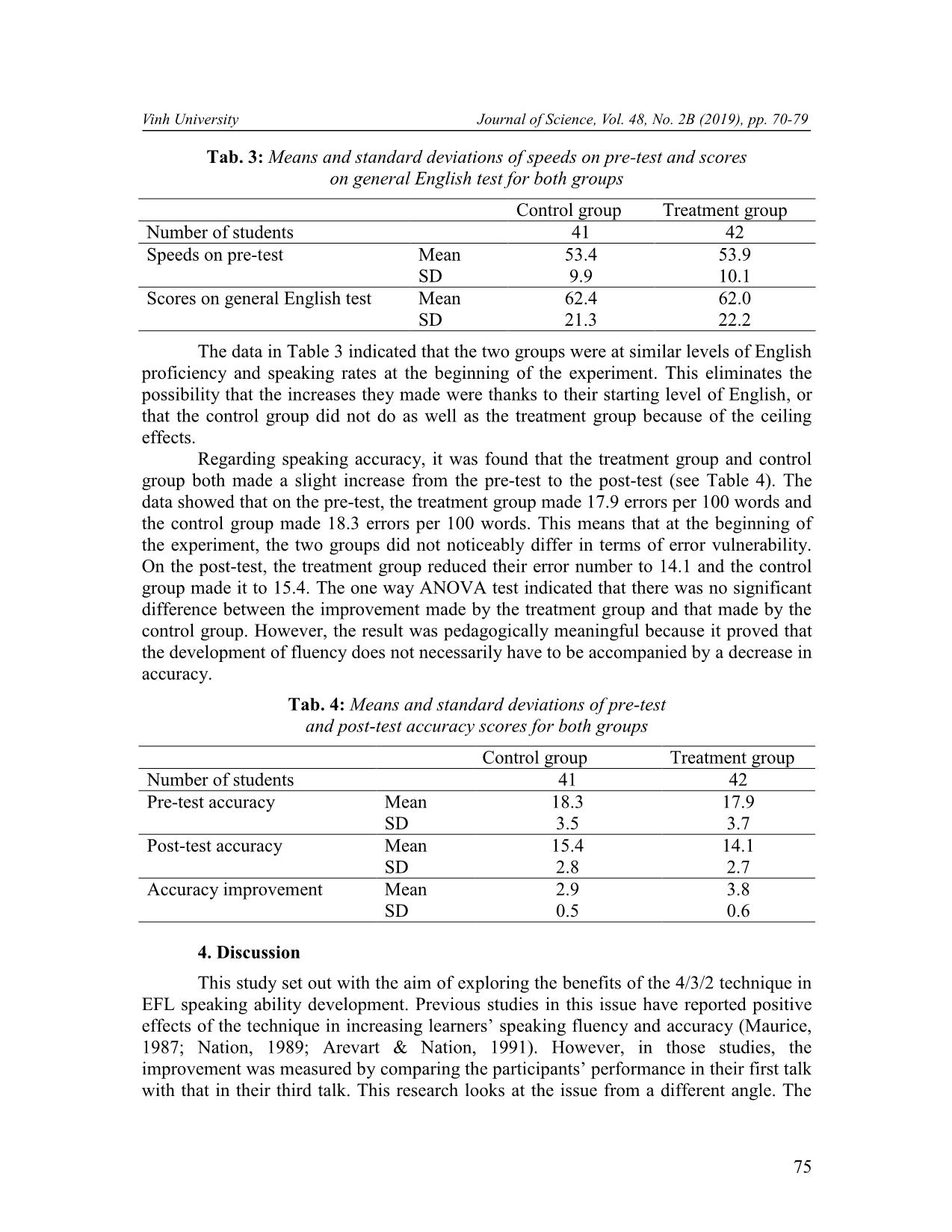
Trang 6
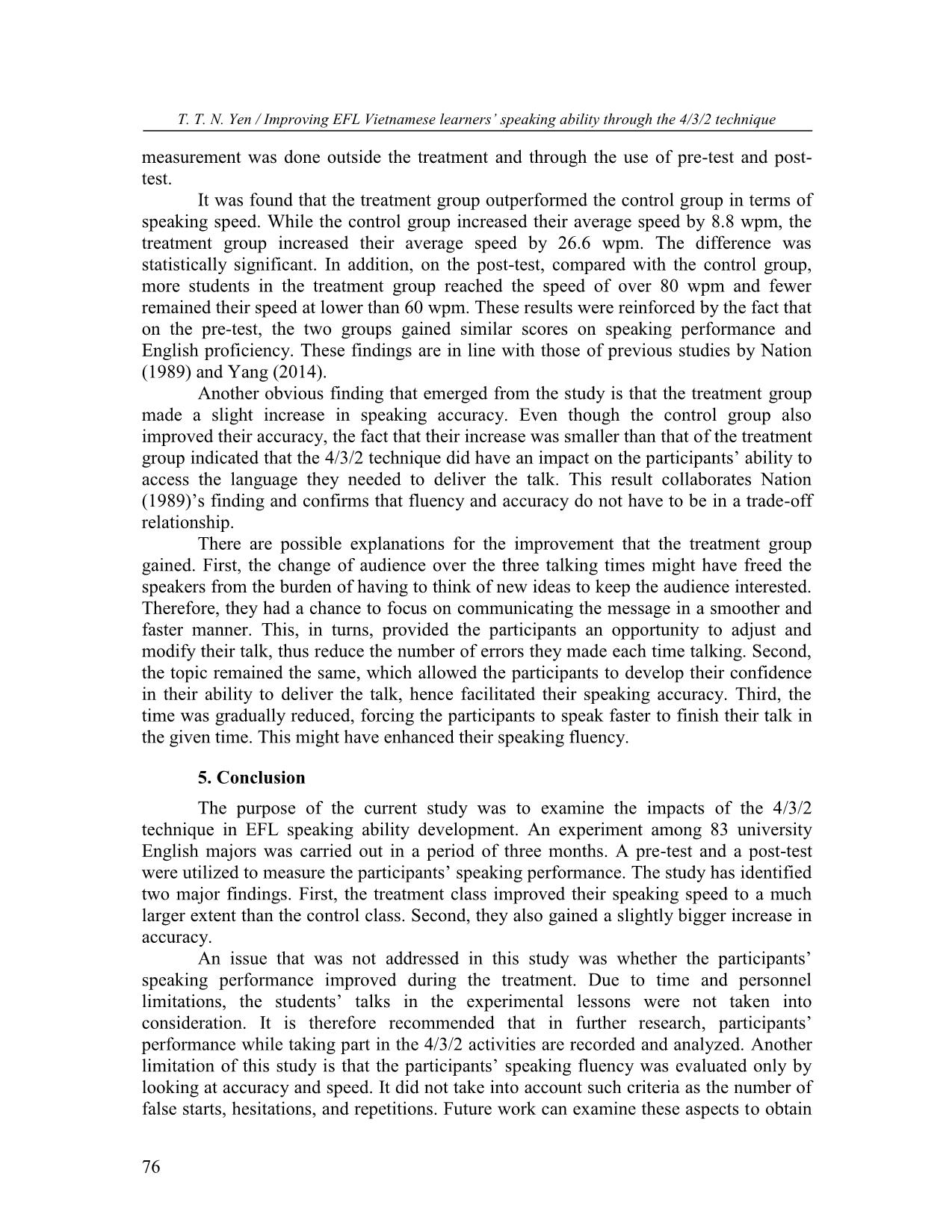
Trang 7
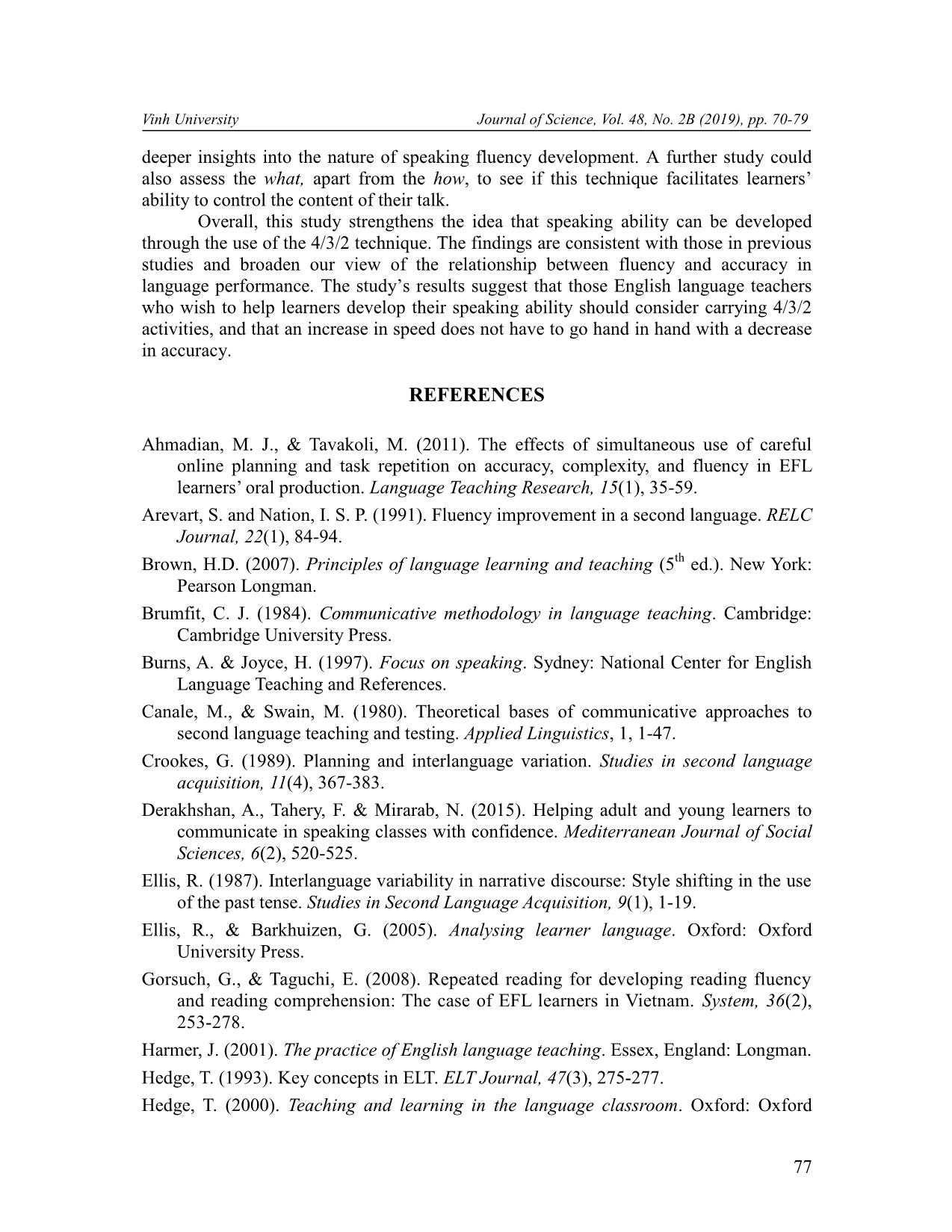
Trang 8
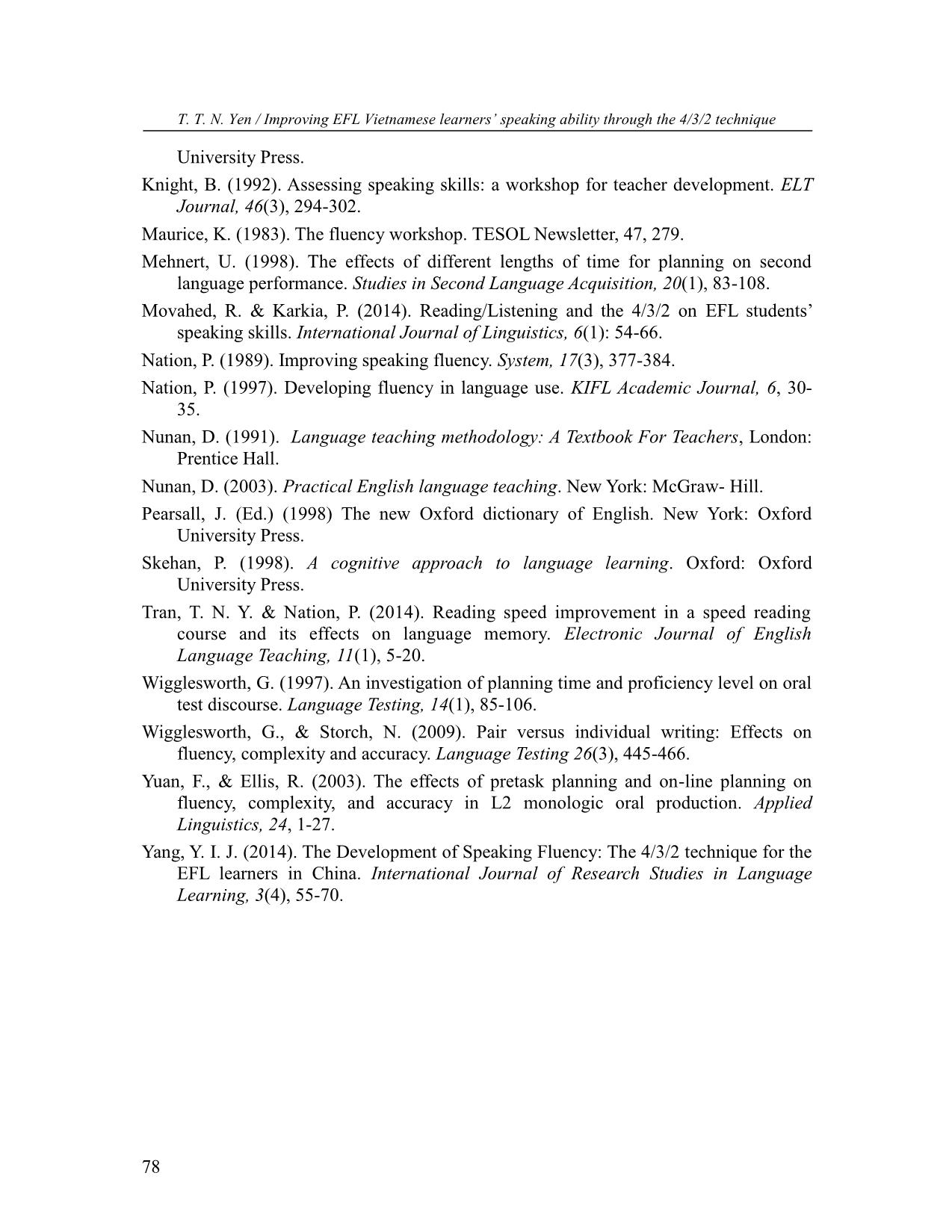
Trang 9
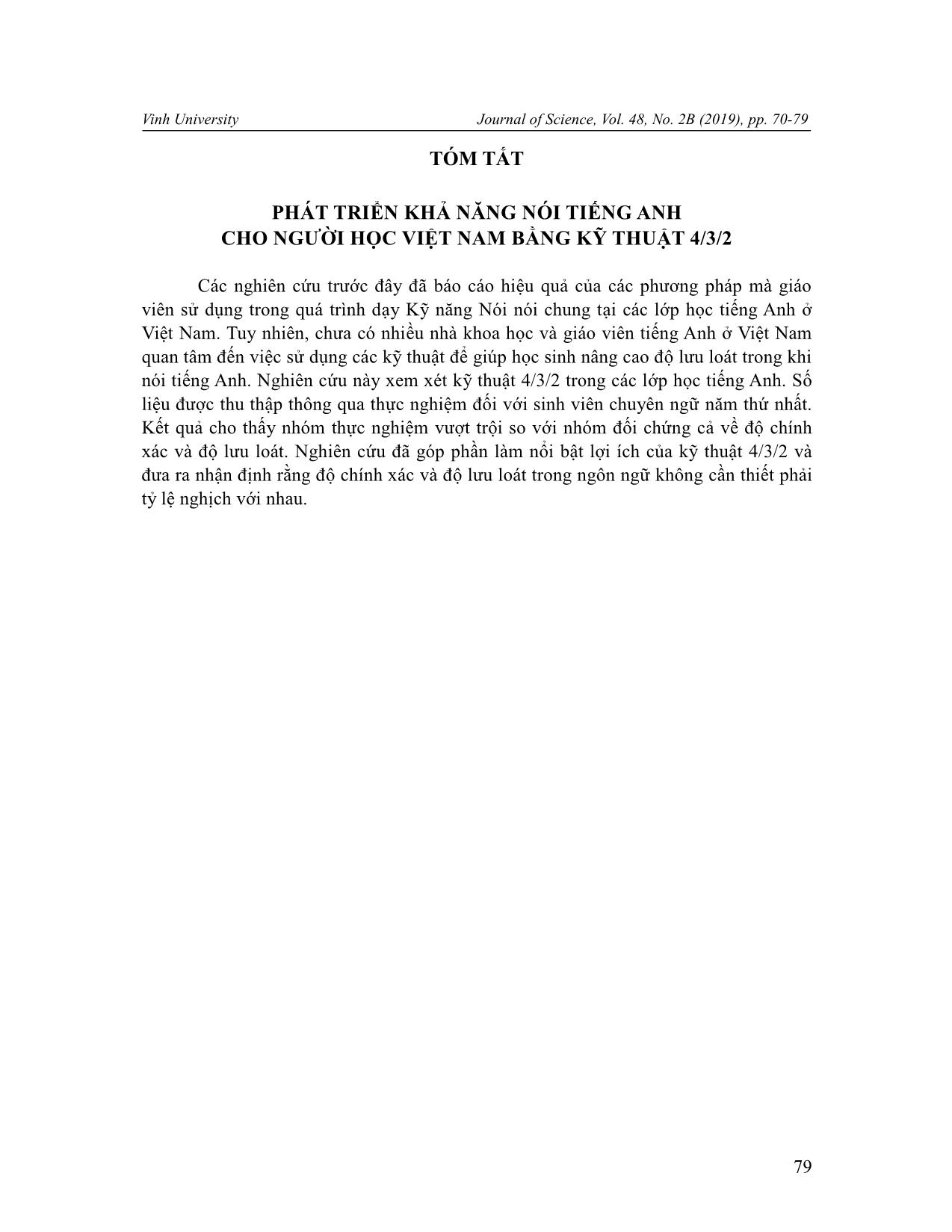
Trang 10
Tóm tắt nội dung tài liệu: Improving EFL Vietnamese learners’ speaking ability through the 4/3/2 technique
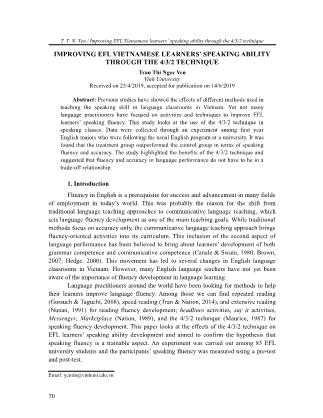
The Reading and Writing section contained five parts of reading and three parts of listening and lasted for 70 minutes. The Listening section contained five parts and lasted for about 30 minutes. In the pre-test, the participants were asked to talk about a topic for two minutes. They had one minute to prepare for their talk. After that, both groups followed the usual English program at the university for three months. During the treatment, the experimental group was asked to T. T. N. Yen / Improving EFL Vietnamese learners’ speaking ability through the 4/3/2 technique 74 do the 4/3/2 activities once a week while this technique was not introduced to the control class. Finally, the two groups did the post-test, which was similar to the pre-test in terms of topic familiarity, difficulty and time allowance. 3.4. Results The participants’ speaking speed was measured by calculating the number of words spoken per minute and their speaking accuracy was measured by calculating the number of errors per 100 words. The per-100-word calculation was used instead of the per-minute calculation because otherwise it might not be fair for students who talked more in a minute. A student who made fewer errors in a minute was not necessarily better than someone who committed more mistakes within this time. It might have been possible that they did not say anything at all and thus made no errors. Regarding the participants’ speaking speed, the data revealed that the treatment group outperformed the control group on the post-test (see Table 1). The average speed at which the control class spoke was 62.3 words per minute (wpm) while the treatment class spoke at the average speed of 80.5 wpm. An examination of the speeds reached by the treatment group showed that only one participant spoke at the speed of under 60 wpm and 14 participants spoke at the speeds of over 80 wpm. The slowest speed was 59 wpm and the fastest speed was 107 wpm. Meanwhile, 13 out of 41 participants in the control group spoke at the speeds of under 60 wpm and only two reached the speeds of over 80 wpm. The slowest speed was 27 wpm and the fastest speed was 82 wpm. Tab. 1: Means and standard deviations of post-test speaking speeds for both groups Control group Treatment group Number of students 41 42 Mean 62.3 80.5 SD 9.7 11.4 The results also indicated that the treatment group significantly increased their speaking speed while the control group just gained a slight increase (see Table 2). Tab. 2: Means and standard deviations of speed increases for both groups Control group Treatment group Number of students 41 42 Mean 8.8 26.6 SD 2.4 9.4 p<0.05 As it can be seen from Table 2, the treatment group made an average increase of 26.6 wpm whereas the control group increased their average speed by 8.8 wpm. The one way ANOVA test results showed that there was a significant difference between the treatment group’s improvement and the control group’s improvement. These results were reinforced by the fact that the two groups had similar average scores on the general English test and on the pre-test (see Table 3). Vinh University Journal of Science, Vol. 48, No. 2B (2019), pp. 70-79 75 Tab. 3: Means and standard deviations of speeds on pre-test and scores on general English test for both groups Control group Treatment group Number of students 41 42 Speeds on pre-test Mean 53.4 53.9 SD 9.9 10.1 Scores on general English test Mean 62.4 62.0 SD 21.3 22.2 The data in Table 3 indicated that the two groups were at similar levels of English proficiency and speaking rates at the beginning of the experiment. This eliminates the possibility that the increases they made were thanks to their starting level of English, or that the control group did not do as well as the treatment group because of the ceiling effects. Regarding speaking accuracy, it was found that the treatment group and control group both made a slight increase from the pre-test to the post-test (see Table 4). The data showed that on the pre-test, the treatment group made 17.9 errors per 100 words and the control group made 18.3 errors per 100 words. This means that at the beginning of the experiment, the two groups did not noticeably differ in terms of error vulnerability. On the post-test, the treatment group reduced their error number to 14.1 and the control group made it to 15.4. The one way ANOVA test indicated that there was no significant difference between the improvement made by the treatment group and that made by the control group. However, the result was pedagogically meaningful because it proved that the development of fluency does not necessarily have to be accompanied by a decrease in accuracy. Tab. 4: Means and standard deviations of pre-test and post-test accuracy scores for both groups Control group Treatment group Number of students 41 42 Pre-test accuracy Mean 18.3 17.9 SD 3.5 3.7 Post-test accuracy Mean 15.4 14.1 SD 2.8 2.7 Accuracy improvement Mean 2.9 3.8 SD 0.5 0.6 4. Discussion This study set out with the aim of exploring the benefits of the 4/3/2 technique in EFL speaking ability development. Previous studies in this issue have reported positive effects of the technique in increasing learners’ speaking fluency and accuracy (Maurice, 1987; Nation, 1989; Arevart & Nation, 1991). However, in those studies, the improvement was measured by comparing the participants’ performance in their first talk with that in their third talk. This research looks at the issue from a different angle. The T. T. N. Yen / Improving EFL Vietnamese learners’ speaking ability through the 4/3/2 technique 76 measurement was done outside the treatment and through the use of pre-test and post- test. It was found that the treatment group outperformed the control group in terms of speaking speed. While the control group increased their average speed by 8.8 wpm, the treatment group increased their average speed by 26.6 wpm. The difference was statistically significant. In addition, on the post-test, compared with the control group, more students in the treatment group reached the speed of over 80 wpm and fewer remained their speed at lower than 60 wpm. These results were reinforced by the fact that on the pre-test, the two groups gained similar scores on speaking performance and English proficiency. These findings are in line with those of previous studies by Nation (1989) and Yang (2014). Another obvious finding that emerged from the study is that the treatment group made a slight increase in speaking accuracy. Even though the control group also improved their accuracy, the fact that their increase was smaller than that of the treatment group indicated that the 4/3/2 technique did have an impact on the participants’ ability to access the language they needed to deliver the talk. This result collaborates Nation (1989)’s finding and confirms that fluency and accuracy do not have to be in a trade-off relationship. There are possible explanations for the improvement that the treatment group gained. First, the change of audience over the three talking times might have freed the speakers from the burden of having to think of new ideas to keep the audience interested. Therefore, they had a chance to focus on communicating the message in a smoother and faster manner. This, in turns, provided the participants an opportunity to adjust and modify their talk, thus reduce the number of errors they made each time talking. Second, the topic remained the same, which allowed the participants to develop their confidence in their ability to deliver the talk, hence facilitated their speaking accuracy. Third, the time was gradually reduced, forcing the participants to speak faster to finish their talk in the given time. This might have enhanced their speaking fluency. 5. Conclusion The purpose of the current study was to examine the impacts of the 4/3/2 technique in EFL speaking ability development. An experiment among 83 university English majors was carried out in a period of three months. A pre-test and a post-test were utilized to measure the participants’ speaking performance. The study has identified two major findings. First, the treatment class improved their speaking speed to a much larger extent than the control class. Second, they also gained a slightly bigger increase in accuracy. An issue that was not addressed in this study was whether the participants’ speaking performance improved during the treatment. Due to time and personnel limitations, the students’ talks in the experimental lessons were not taken into consideration. It is therefore recommended that in further research, participants’ performance while taking part in the 4/3/2 activities are recorded and analyzed. Another limitation of this study is that the participants’ speaking fluency was evaluated only by looking at accuracy and speed. It did not take into account such criteria as the number of false starts, hesitations, and repetitions. Future work can examine these aspects to obtain Vinh University Journal of Science, Vol. 48, No. 2B (2019), pp. 70-79 77 deeper insights into the nature of speaking fluency development. A further study could also assess the what, apart from the how, to see if this technique facilitates learners’ ability to control the content of their talk. Overall, this study strengthens the idea that speaking ability can be developed through the use of the 4/3/2 technique. The findings are consistent with those in previous studies and broaden our view of the relationship between fluency and accuracy in language performance. The study’s results suggest that those English language teachers who wish to help learners develop their speaking ability should consider carrying 4/3/2 activities, and that an increase in speed does not have to go hand in hand with a decrease in accuracy. REFERENCES Ahmadian, M. J., & Tavakoli, M. (2011). The effects of simultaneous use of careful online planning and task repetition on accuracy, complexity, and fluency in EFL learners’ oral production. Language Teaching Research, 15(1), 35-59. Arevart, S. and Nation, I. S. P. (1991). Fluency improvement in a second language. RELC Journal, 22(1), 84-94. Brown, H.D. (2007). Principles of language learning and teaching (5th ed.). New York: Pearson Longman. Brumfit, C. J. (1984). Communicative methodology in language teaching. Cambridge: Cambridge University Press. Burns, A. & Joyce, H. (1997). Focus on speaking. Sydney: National Center for English Language Teaching and References. Canale, M., & Swain, M. (1980). Theoretical bases of communicative approaches to second language teaching and testing. Applied Linguistics, 1, 1-47. Crookes, G. (1989). Planning and interlanguage variation. Studies in second language acquisition, 11(4), 367-383. Derakhshan, A., Tahery, F. & Mirarab, N. (2015). Helping adult and young learners to communicate in speaking classes with confidence. Mediterranean Journal of Social Sciences, 6(2), 520-525. Ellis, R. (1987). Interlanguage variability in narrative discourse: Style shifting in the use of the past tense. Studies in Second Language Acquisition, 9(1), 1-19. Ellis, R., & Barkhuizen, G. (2005). Analysing learner language. Oxford: Oxford University Press. Gorsuch, G., & Taguchi, E. (2008). Repeated reading for developing reading fluency and reading comprehension: The case of EFL learners in Vietnam. System, 36(2), 253-278. Harmer, J. (2001). The practice of English language teaching. Essex, England: Longman. Hedge, T. (1993). Key concepts in ELT. ELT Journal, 47(3), 275-277. Hedge, T. (2000). Teaching and learning in the language classroom. Oxford: Oxford T. T. N. Yen / Improving EFL Vietnamese learners’ speaking ability through the 4/3/2 technique 78 University Press. Knight, B. (1992). Assessing speaking skills: a workshop for teacher development. ELT Journal, 46(3), 294-302. Maurice, K. (1983). The fluency workshop. TESOL Newsletter, 47, 279. Mehnert, U. (1998). The effects of different lengths of time for planning on second language performance. Studies in Second Language Acquisition, 20(1), 83-108. Movahed, R. & Karkia, P. (2014). Reading/Listening and the 4/3/2 on EFL students’ speaking skills. International Journal of Linguistics, 6(1): 54-66. Nation, P. (1989). Improving speaking fluency. System, 17(3), 377-384. Nation, P. (1997). Developing fluency in language use. KIFL Academic Journal, 6, 30- 35. Nunan, D. (1991). Language teaching methodology: A Textbook For Teachers, London: Prentice Hall. Nunan, D. (2003). Practical English language teaching. New York: McGraw- Hill. Pearsall, J. (Ed.) (1998) The new Oxford dictionary of English. New York: Oxford University Press. Skehan, P. (1998). A cognitive approach to language learning. Oxford: Oxford University Press. Tran, T. N. Y. & Nation, P. (2014). Reading speed improvement in a speed reading course and its effects on language memory. Electronic Journal of English Language Teaching, 11(1), 5-20. Wigglesworth, G. (1997). An investigation of planning time and proficiency level on oral test discourse. Language Testing, 14(1), 85-106. Wigglesworth, G., & Storch, N. (2009). Pair versus individual writing: Effects on fluency, complexity and accuracy. Language Testing 26(3), 445-466. Yuan, F., & Ellis, R. (2003). The effects of pretask planning and on-line planning on fluency, complexity, and accuracy in L2 monologic oral production. Applied Linguistics, 24, 1-27. Yang, Y. I. J. (2014). The Development of Speaking Fluency: The 4/3/2 technique for the EFL learners in China. International Journal of Research Studies in Language Learning, 3(4), 55-70. Vinh University Journal of Science, Vol. 48, No. 2B (2019), pp. 70-79 79 TÓM TẮT PHÁT TRIỂN KHẢ NĂNG NÓI TIẾNG ANH CHO NGƯỜI HỌC VIỆT NAM BẰNG KỸ THUẬT 4/3/2 Các nghiên cứu trước đây đã báo cáo hiệu quả của các phương pháp mà giáo viên sử dụng trong quá trình dạy Kỹ năng Nói nói chung tại các lớp học tiếng Anh ở Việt Nam. Tuy nhiên, chưa có nhiều nhà khoa học và giáo viên tiếng Anh ở Việt Nam quan tâm đến việc sử dụng các kỹ thuật để giúp học sinh nâng cao độ lưu loát trong khi nói tiếng Anh. Nghiên cứu này xem xét kỹ thuật 4/3/2 trong các lớp học tiếng Anh. Số liệu được thu thập thông qua thực nghiệm đối với sinh viên chuyên ngữ năm thứ nhất. Kết quả cho thấy nhóm thực nghiệm vượt trội so với nhóm đối chứng cả về độ chính xác và độ lưu loát. Nghiên cứu đã góp phần làm nổi bật lợi ích của kỹ thuật 4/3/2 và đưa ra nhận định rằng độ chính xác và độ lưu loát trong ngôn ngữ không cần thiết phải tỷ lệ nghịch với nhau.
File đính kèm:
 improving_efl_vietnamese_learners_speaking_ability_through_t.pdf
improving_efl_vietnamese_learners_speaking_ability_through_t.pdf

